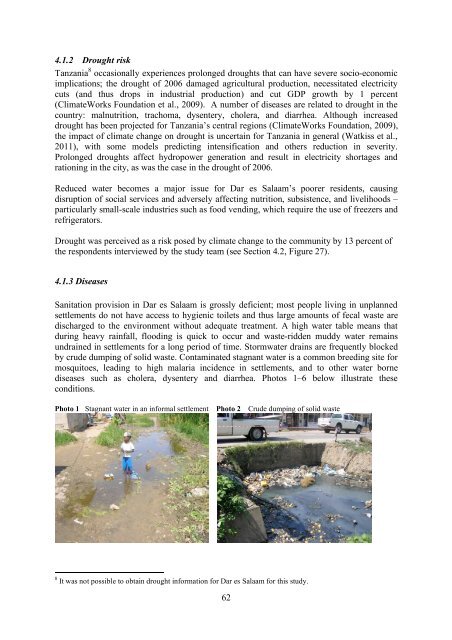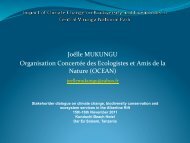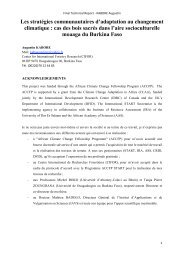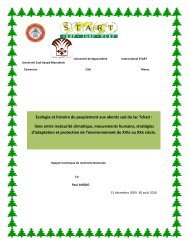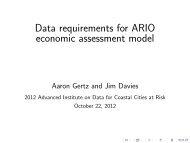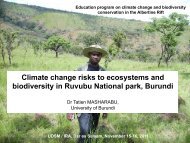Urban Poverty & Climate Change in Dar es Salaam, Tanzania:
Urban Poverty & Climate Change in Dar es Salaam, Tanzania:
Urban Poverty & Climate Change in Dar es Salaam, Tanzania:
You also want an ePaper? Increase the reach of your titles
YUMPU automatically turns print PDFs into web optimized ePapers that Google loves.
4.1.2 Drought risk<br />
<strong>Tanzania</strong> 8 occasionally experienc<strong>es</strong> prolonged droughts that can have severe socio-economic<br />
implications; the drought of 2006 damaged agricultural production, nec<strong>es</strong>sitated electricity<br />
cuts (and thus drops <strong>in</strong> <strong>in</strong>dustrial production) and cut GDP growth by 1 percent<br />
(<strong>Climate</strong>Works Foundation et al., 2009). A number of diseas<strong>es</strong> are related to drought <strong>in</strong> the<br />
country: malnutrition, trachoma, dysentery, cholera, and diarrhea. Although <strong>in</strong>creased<br />
drought has been projected for <strong>Tanzania</strong>’s central regions (<strong>Climate</strong>Works Foundation, 2009),<br />
the impact of climate change on drought is uncerta<strong>in</strong> for <strong>Tanzania</strong> <strong>in</strong> general (Watkiss et al.,<br />
2011), with some models predict<strong>in</strong>g <strong>in</strong>tensification and others reduction <strong>in</strong> severity.<br />
Prolonged droughts affect hydropower generation and r<strong>es</strong>ult <strong>in</strong> electricity shortag<strong>es</strong> and<br />
ration<strong>in</strong>g <strong>in</strong> the city, as was the case <strong>in</strong> the drought of 2006.<br />
Reduced water becom<strong>es</strong> a major issue for <strong>Dar</strong> <strong>es</strong> <strong>Salaam</strong>’s poorer r<strong>es</strong>idents, caus<strong>in</strong>g<br />
disruption of social servic<strong>es</strong> and adversely affect<strong>in</strong>g nutrition, subsistence, and livelihoods –<br />
particularly small-scale <strong>in</strong>dustri<strong>es</strong> such as food vend<strong>in</strong>g, which require the use of freezers and<br />
refrigerators.<br />
Drought was perceived as a risk posed by climate change to the community by 13 percent of<br />
the r<strong>es</strong>pondents <strong>in</strong>terviewed by the study team (see Section 4.2, Figure 27).<br />
4.1.3 Diseas<strong>es</strong><br />
Sanitation provision <strong>in</strong> <strong>Dar</strong> <strong>es</strong> <strong>Salaam</strong> is grossly deficient; most people liv<strong>in</strong>g <strong>in</strong> unplanned<br />
settlements do not have acc<strong>es</strong>s to hygienic toilets and thus large amounts of fecal waste are<br />
discharged to the environment without adequate treatment. A high water table means that<br />
dur<strong>in</strong>g heavy ra<strong>in</strong>fall, flood<strong>in</strong>g is quick to occur and waste-ridden muddy water rema<strong>in</strong>s<br />
undra<strong>in</strong>ed <strong>in</strong> settlements for a long period of time. Stormwater dra<strong>in</strong>s are frequently blocked<br />
by crude dump<strong>in</strong>g of solid waste. Contam<strong>in</strong>ated stagnant water is a common breed<strong>in</strong>g site for<br />
mosquito<strong>es</strong>, lead<strong>in</strong>g to high malaria <strong>in</strong>cidence <strong>in</strong> settlements, and to other water borne<br />
diseas<strong>es</strong> such as cholera, dysentery and diarrhea. Photos 1–6 below illustrate th<strong>es</strong>e<br />
conditions.<br />
Photo 1 Stagnant water <strong>in</strong> an <strong>in</strong>formal settlement Photo 2 Crude dump<strong>in</strong>g of solid waste<br />
8 It was not possible to obta<strong>in</strong> drought <strong>in</strong>formation for <strong>Dar</strong> <strong>es</strong> <strong>Salaam</strong> for this study.<br />
62


